Unit 8 has two primary objectives:
 to review the uses of fractions and
to review the uses of fractions and
fraction notation
 to help children develop a solid
understanding of
to help children develop a solid
understanding of
equivalent fractions , or fractions that have
the same value
The second objective is especially important, because
understanding equivalent fractions will help children
compare fractions and, later, calculate with fractions.
Children will build their understanding of equivalent
fractions by working with Fraction Cards and
name-collection boxes. Fraction Cards are shaded to
show a variety of fractions.
Name-collection boxes contain equivalent names for the
same number. For example, a  name-collection
name-collection
box can contain fractions such as  , and
, and
 and the
and the
decimal 0.50.
Children will also generate lists of equivalent fractions by
folding circles and rectangles into different numbers of equal parts.
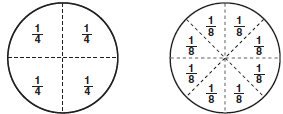
Throughout this unit, children will make up and solve
number stories involving fractions in everyday contexts.
They will solve number stories about collections of
real -world objects such as crayons, books, and cookies.
Finally, children will begin to name quantities greater than
1 with fractions such as
 and
and  and
with mixed numbers
and
with mixed numbers
such as  .
.
Please keep this Family Letter for reference as
your child works through Unit 8.
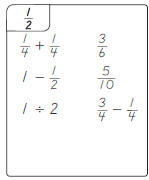
Vocabulary
Important terms in Unit 8:
fraction A number in the form
 where a and b are
where a and b are
whole numbers and b is not 0. A fraction may be
used to name part of a whole, to compare two
quantities, or to represent division. For example,

can be thought of as 2 divided by 3.
denominator The number below the line in a
fraction. A fraction may be used to name part of a
whole. If the whole is divided into equal parts, the
denominator represents the number of equal parts
into which the whole (the ONE or unit whole) is
divided. In the fraction  , b is the
denominator.
, b is the
denominator.
numerator
denominator |
 |
number of parts shade
number of equal parts |
 |

numerator The number
above the line in a fraction.
A fraction may be used to
name part of a whole. If
the whole (the ONE or
unit whole) is divided into
equal parts, the numerator represents the number of
equal parts being considered. In the fraction  ,
a is
,
a is
the numerator.
equivalent fractions Fractions with different
denominators that name the same number. For
example,  and
and
 are equivalent fractions.
are equivalent fractions.
mixed number A number that is written using
both a whole number and a fraction. For example,
 is a mixed number equal to
is a mixed number equal to
 .
.
Building Skills through Games
In Unit 8, your child will practice multiplication skills , build his or
her understanding
of fractions, and practice skills related to chance and probability by
playing the following
games. For detailed instructions, see the Student Reference Book.
Baseball Multiplication
Players use multiplication facts to score runs. Team members take turns
pitching by rolling
two dice to get two factors. Then players on the batting team take turns
multiplying the
two factors and saying the product .
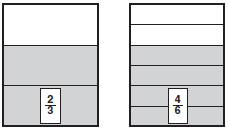
Equivalent Fractions Game
Players take turns turning over Fraction Cards and try
to find matching cards that show equivalent fractions.
Fraction Top-It
Players turn over two Fraction Cards and compare the shaded parts of the
cards. The player
with the larger fraction keeps all the cards. The player with more cards
at the end wins!
The Block- Drawing Game
Without letting the other players see the blocks, a Director puts five
blocks in a paper bag and
tells the players how many blocks are in the bag. A player takes a block
out of the bag. The
Director records the color of the block for all players to see. The
player replaces the block. At
any time, a player may say Stop! and guess how many blocks of each color
are in the bag. |
Do-Anytime Activities
To work with your child on the concepts taught in this unit and in previous
units , try these interesting and
rewarding activities:
1. Help your child find fractions in the everyday world—in advertisements, on
measuring tools, in
recipes, and so on.
2. Count together by a 1- digit number . For example, start at 0 and count by 7s.
3. Dictate 5-, 6-, and 7-digit numbers for your child to write, such as thirteen
thousand, two hundred
forty-seven (13,247) and three million, two hundred twenty-nine thousand, eight
hundred fifty-six
(3,229,856). Also, write 5-, 6-, and 7- digit numbers for your child to read to
you.
4. Practice extended multiplication and division facts such as 3× 7 __, 30 ×7
__, and 300× 7 __,
and 18÷ 6 __, 180 ÷6 __, and 1,800 ÷6 __.
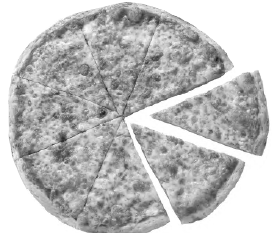
As You Help Your Child with Homework
As your child brings home assignments, you may want to go over the instructions
together, clarifying
them as necessary. The answers listed below will guide you through this unit’s
Home Links.
Home Link 8
 1
1

Home Link 8 2
2

Home Link 8 3
3

Home Link 8 4
4
1. 9 pieces of fruit,

Home Link 8
 5
5


Home Link 8 6
6
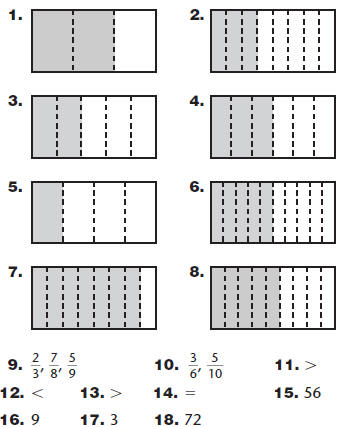
Home Link 8
 7
7

Home Link 8 8
8
1. 8 eggs
2.  of the lawn
of the lawn
3. 2 miles
4. trays
trays
5.  gallon
gallon
6. 6,761
7. 2,908
8. 9,524



